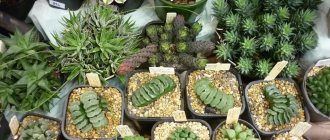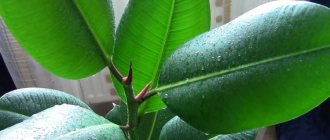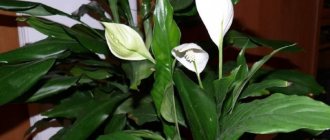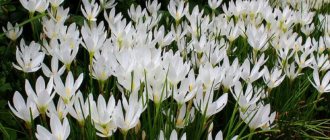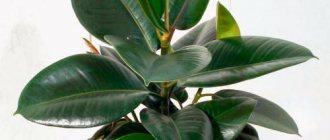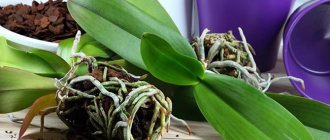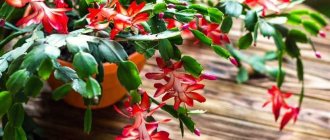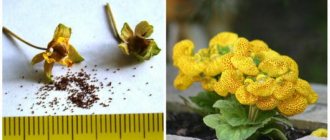Ficus Barok: tips for care, propagation and replanting
Ficus is an amazing plant with an amazing variety of species and varieties that today we can grow simply at home. So Ficus Barok ( Ficus Barok ) is a pearl among them, one of the varieties of Benjamin, and can rightfully be called the most unusual.
It's all about the bizarre shape of its leaves, which look twisted due to the arched vein. In addition, each leaf has a glossy, leathery green upper plate and a more faded lower plate, as well as smooth edges. They grow from 3 cm to 4 cm in length, and up to 2 cm in width. Each leaf has a dense, straight petiole. Ficus Baroque, although it grows slowly, still tries to do so rapidly. However, due to the fact that the trunk and side shoots are weak and thin, the crown, in general, looks rather sparse. But flower growers have found a solution to this - they plant several (2-3) ficuses in one pot. Then not a lonely tree grows, but a lush and curly bush, which will simply become an indispensable addition to any interior. Ficus Baroque photo
Ficus rubbery (elastic) - f. elastica
Some of the most popular and beloved ficus trees are tree-like. The most famous of them is ficus rubber or elastic. This tropical evergreen can reach almost 10 meters indoors, but is usually kept shaped at 2 or 3 meters.
Particularly attractive for this type of ficus are the large leaves with a glossy upper part. Their length is usually from 20 to 30 cm in length, and their width is from 10 to 20 cm. The leaves are attached to the trunks alternately using small petioles.
Forms with green leaves are the most unpretentious. The same applies to varieties with dark colors: “Abidjan”, “Black Prince”. The first leaves have a dark burgundy tint, while the second has a blackish tint.
Variegated varieties and forms are more capricious. For example, "Belize" has tricolor leaves, green in the center, white and pink around the edges. Or "Teneke" with a white pattern on a green background.
This ornamental crop is undemanding to growing conditions, but it blooms quite rarely in an apartment. When caring, remember that the white sap of ficus elastica is poisonous. And you need to be careful when working with it.
Caring for ficus Baroque at home
In general, the ficus itself is not very demanding to handle, including the Ficus Benjamin Baroque. But in order for the plant to please you with its appearance, and not cause you worries, you need to follow simple rules that determine the correct care for it.
- Lighting : loves bright, diffused light. However, in order to protect the plant from burns on a hot summer day, it needs to be shaded from direct sunlight.
- Temperature : in summer, the most optimal temperature will be +23°C - +25°C. In winter, Barok likes moderate warmth - +12°C - +15°C.
It is worth remembering that Ficus Baroque is very sensitive to sudden changes in temperature and can react to irritation by dropping leaves.
- Watering : this ficus likes more or less abundant watering in spring and summer, and reduced in winter. But do not overwater the plant; its soil must dry out to about 2 cm deep before you water it again.
- Air humidity : Baroque can tolerate dry air quite well - this is very important especially in winter, when there is not enough humidity due to radiator heating. And yet the plant will respond gratefully to spraying.
It is important to know that dry air can cause spider mites to appear. Due to the unusual shape of the Baroka leaf, you risk not noticing this pest. To protect your plant, you need to wash it in the shower once every 1-2 weeks, or even better, immerse the crown in warm water for 3-7 minutes.
- Replanting : young plants are recommended to be replanted every spring, and more mature ones - once every 1-2 years. And sometimes, instead of replanting, you can simply change the top layer of soil.
- Fertilizing : fertilizing ficus with curly leaves is done with organic and mineral liquid substrates, 2 times a month during the period of active plant growth.
- Reproduction : like other varieties of Benjamin, Baroque can be propagated by cuttings, however, there are cases of propagation by seeds. Particularly skilled flower growers can do this with air layering.
And so we met another variety of ficus Benjamin, which surprised us with its unusual appearance. Ficus Baroque can become an exotic highlight in your home and complement your home green “collection”.
How to care for ficus?
Ficuses are wild plants belonging to the Mulberry family. Depending on the species, they can be giant trees, shrubs, or ordinary vines. Many of them, like orchids, are epiphytes. This means that in their natural environment they grow on the trunks or stems of other plants, after which they develop their own root system and grow to impressive sizes. Their height can reach 30 m, which is a height of 10 floors. Having a spreading and developed crown, ficus can create a shadow the size of a hectare.
The most famous representatives of the genus are the fig tree, or, as it is also called, the date or fig. The inhabitants of Arabia began cultivating this crop even before our era, after which they passed on their skills to the Phoenicians. The plant occupied a special place in the life of the ancient people, because in honor of it they even decided to name their country Phenicia.
Ficuses have always been considered a very valuable plant, and it’s not just about the juicy and nutritious fruits. Residents of Asia once grew trees as a money talisman, since the shape of the leaves resembled coins. Nowadays, in Colombia and Ecuador, rubber is extracted from ficus; in Mexico and Central America, large leaves are used to make house roofs and sun canopies. Muslims and Buddhists treat fig trees as sacred objects. But ficuses bring the main benefit to folk medicine, since all parts of the plant contain milky sap. It is taken orally or used as an ointment for external use.
After many centuries, ficus moved to window sills in apartments and houses. The plant is often used for office landscaping. Ficus leaves purify oxygen well and make the room fresh. But for this, ficus care must be correct.
More than 1,500 species of ficus grow in the wild, most of which prefer the tropical climates of America, Africa and Australia. There are about 20 domestic species, all of them differ in appearance, size and some growing characteristics. Many gardeners prefer ficus rubber, dwarf or ficus Benjamin.
Household ficuses are quite unpretentious to care for. Despite the diversity of species, almost all follow the same rules of care. Before you start caring for a ficus, you need to study all the conditions for its cultivation.
Since the plant’s homeland is the tropics, in a home climate, ficuses prefer high air humidity, plenty of sun and moderate temperatures. But drafts and hypothermia can have a detrimental effect on the health of the tree, so it is better to place the pot in a place protected from these phenomena. It is also not worth moving the ficus often - trees like to stay in one place and react painfully to moving.
Caring for ficus at home consists of several simple rules.
Priming
The composition of the soil in the pot is selected according to the type of ficus.
- For small varieties and young plants, light soil that allows oxygen and water to pass through is suitable. The composition is mixed from equal proportions of sand, peat and leaf soil.
- For large and mature ficuses, denser soil containing humus, turf soil, and compost is used.
- You can purchase commercial soil specifically designed for growing ficus. Such mixtures already contain all the nutrients, however, before planting, the soil must be disinfected so that the ficus is not attacked by pests and diseases. To do this, the soil is spilled with boiling water or a weak solution of potassium permanganate.
Before planting in a pot, a drainage layer of expanded clay or charcoal is formed at the bottom. Excess moisture will not accumulate at the base of the plants and cause rotting of the roots.
Temperature
Ficuses are heat-loving plants that react sharply to lower temperatures. When caring for indoor ficus, it is important to observe the temperature regime, otherwise your pet may lose its leaves.
The optimal growing temperature for all species differs depending on the season of the year:
- In summer – +25-30°C;
- In winter – +16-25 °C.
During the cold period, do not place the pot on a cold windowsill or on the floor together with other flowers - this can cause hypothermia. To prevent the root system from freezing, place a sheet of foam plastic or other material that retains heat under the pot.
However, different types of ficus behave differently in different temperature conditions, so it is necessary to adapt to the characteristics of each:
- The rubber-bearing ficus prefers moderate temperatures - not lower than +18°C;
- Ficus Benjamin and Ali feel great at +20-25°C, but can withstand temperature drops down to +13°. Make sure that the decline is not sudden, otherwise the tree may lose its leaves.
- Lyre-shaped ficus, on the contrary, does not like extreme heat and grows well at +18-20°C. The minimum limit for it is +12°C, after which the plant begins to shed its leaves.
- Dwarf ficus is the most resistant to temperature changes. In nature, it grows successfully at +8°C and is even able to tolerate frost. At home, set a stable temperature at +20-25°C and try not to lower it below +12-14°C.
Ficus plants react painfully to sudden cold snaps and cold soil, so you should not water the plant with cold water.
Lighting
To properly care for your ficus, you need to choose in advance a place where the green beauty will feel great. It should be a well-lit place with plenty of sunlight.
With a lack of lighting, ficus leaves begin to thin and lose vitality, and the shoots stretch towards the sun and spoil the appearance of the entire flower. If a window sill is chosen as a new habitat, it is preferable to choose windows on the western or eastern side of the apartment.
Some varieties, on the contrary, grow and develop better in the shade, so it is better to protect them from exposure to ultraviolet radiation.
- Rubber-bearing ficus is a light-loving plant that is placed in a bright and warm place. After lunch, when the sun's exposure is especially strong, the leaves of the flower must be protected. Plants with variegated leaves tolerate bright light more readily, while plants with dark leaves prefer shade.
- Ficus benjamina especially loves light, but it also needs to be protected from the sun in the afternoon. The eastern side is perfect in summer, and the southern side in winter. When there is a lack of lighting, the ficus begins to shed its leaves.
- Ficus Ali grows well in moderate light in light partial shade. The bright sun in the hot season leaves burns on the leaves, and its lack leads to wilting of the leaves.
- The lyre-shaped ficus is placed in a bright place and provided with protection from bright sun from 11 a.m. to 4 p.m. all year round.
- The dwarf ficus Pumila responds positively to bright diffused light with darkening during particularly hot hours in the afternoon, and also responds well to artificial lighting.
Ficus plants are always drawn to the light, so the pot must be constantly turned towards the light source. This way the plant will form a beautiful crown, otherwise it may stretch out, bend and burn.
Humidity
The tropical plant loves high humidity in the room, from 50 to 70%. In order for ficuses to grow faster, it is necessary to create comfortable conditions for them in the apartment and increase the humidity, especially in the summer months.
- Spray the crown with a spray bottle with warm filtered or settled water.
- Give the plant a “shower” - water the leaves with rain. The water should not be cold and should not get into the ground, so it is recommended to cover the pot with polyethylene or other material. You should refrain from “bath procedures” if the room temperature is below +18°, as the ficus may freeze.
- Wipe large-leaved trees with a damp cloth to remove dust - its excessive accumulation interferes with the normal growth and development of the flower.
- In winter, place a container of water next to the pot - this will help maintain the humidity level at the optimal level.
Watering
Caring for a ficus does not imply strict adherence to a watering schedule, such as, for example, how to properly water an orchid. But it is important to observe moderation. If there is insufficient watering, the plant will begin to die; waterlogging of the soil can cause rotting of the roots and the development of diseases.
The main reference point is dried soil in a pot. To determine the need for watering, plunge your finger into the pot a few centimeters deep. If the soil has dried out at a distance of 2 cm from the surface, it is time to water the ficus.
Water for irrigation should be at room temperature. It is pre-settled or filtered to remove harmful impurities.
Depending on the type of home ficus, care and watering for it will differ:
- Rubber-bearing and lyre-shaped ficuses like moderate watering without waterlogging the soil.
- Ficus benjamina reacts very painfully to heavy watering due to its structure. The roots of the plant have seals on the roots that store moisture. If you overwater the tree, the root system will begin to rot, and the ficus itself will shed most of its leaves or lose their natural color.
- Ficus Ali is watered depending on the time of year. In summer, you need to wait until the pot is half dry; in winter, the frequency of watering is reduced due to a drop in temperature and amount of light. At this time, you need to water the ficus as soon as the soil dries completely.
- Dwarf ficuses are one of the few that do not tolerate drying out of the soil and require more frequent watering. Water the flower as the soil dries out a quarter of the pot.
To avoid rot, always remove excess moisture from the pan.
Transfer
Transplanting flowers is a responsible process. When changing its habitat, the plant receives severe stress, which can negatively affect its development.
The frequency of transplants depends on the age of the ficus:
- Up to 4 years. The plant is constantly growing, so for its proper development it is necessary to constantly change the substrate and pot to a more spacious one.
- From 4 years. Adult plants are replanted once every 5-6 years, but it is better not to disturb the oldest and largest ficuses - it is enough to update the top layer of soil once a year.
Transplantation is carried out in the first weeks of spring, at the beginning of the growing season. Choose a pot 2 cm larger than the old one for small plants, and 5-6 cm larger for large ones. The taller the ficus, the deeper the container should be.
- The day before transplanting, water the ficus well.
- At the bottom of the new container, form a drainage layer of expanded clay.
- Carefully remove the ficus from the old pot and shake the roots off the ground.
- Place the plant in a new container and fill the free space with fresh soil, leaving 2-3 cm to the edge of the pot.
- If necessary, make a support for the ficus - place a peg or stick in the substrate and tie the tree trunk to it.
- Water the transplanted ficus and place it in the chosen place.
The rules for caring for a ficus after transplantation do not differ from standard recommendations. Maintain heat and humidity conditions, try to move the pot less often so as not to disrupt the process of adaptation of the ficus to new conditions. The first feeding is carried out no earlier than a month after transplantation.
Fertilizer and feeding
For proper development and rapid growth of green mass, ficus trees must be fed regularly. As a rule, mineral and biological fertilizers alternate. Ready-made formulations can be purchased in specialized stores - they contain the entire range of useful microelements for tropical plants.
Compost, mullein or bird droppings are used as organic fertilizers. But even here it is necessary to observe moderation - an excess of fertilizers can simply “burn” the plant.
To avoid negative consequences, follow some recommendations:
- Fertilizers are applied to moist soil a few hours after watering, but under no circumstances “to dry soil.”
- You can feed the plant at the same time as watering. Then the concentration of fertilizer is reduced so as not to harm the roots.
- In the spring, during the growing season, ficus is fed once every 2 weeks.
- In winter, feeding is suspended. If artificial lighting and proper air humidification are used, the plant continues to grow. In this case, fertilizing is applied less frequently - once a month.
- Immediately after transplantation, the soil cannot be fertilized, as it is oversaturated with useful substances. An excess of vitamins and minerals can be more detrimental to ficus than their deficiency.
Reproduction
All ficus plants can be propagated by several methods. Cuttings are the easiest way to get a new plant from an existing one. This option is most suitable for deciduous varieties of ficus, including Ficus Benjamin.
Propagation by cuttings is best done with plants that have already reached the age of 2 years. The cutting can be taken either from the top of the tree or from the stem. The shoot should have several leaves.
The process itself is carried out as follows:
- Select a healthy cutting and separate it with a sharp, disinfected tool at an angle - this will make it easier for it to absorb moisture.
- Rinse the cut of the cutting with water and dry for a while.
- Place the shoot in a container with water and put it in a warm place for 3-4 weeks. The temperature should be around +24°C for the cutting to take root successfully.
- As soon as the root system gets stronger and young leaves appear on the shoot, it can be transplanted into a pot.
In unfavorable conditions, the ficus becomes painful and refuses to fully develop.
- Bad light. If a tree does not receive the required dose of light, especially in winter, it stops growing, the leaf blade turns yellow, and over time all the foliage may fall off.
- Low temperature. At low temperatures in the apartment and frequent drafts, the ficus begins to wither and sheds its green mass.
- Overflow. Ficus does not tolerate excessive soil moisture, so it begins to wither, rot forms in the roots, the leaves turn yellow and fall off.
- Moisture deficiency. The downside of not following the watering regime is drying out of the ficus. When there is a lack of moisture, the foliage curls, turns yellow and falls off.
- Excess fertilizer. The increased content of nutrients in the soil causes a burn reaction in the root system, and the ficus dies.
If you know how to care for a ficus in a pot, such problems can be avoided. And then the ficus will become a decoration for any interior.
general description
Ficus Benjamin "Baroque" belongs to the Mulberry family.
Distributed throughout the world from China, India, Australia and Thailand.
It differs from other ficus trees by being more tree-like and having smaller leaf sizes.
The tip of each leaf forms a trench for water to drain.
This adaptation was formed in the plant due to frequent rains in its homeland.
Ficus Benjamin "Baroque" is highly valued in the gardening community.
It is unpretentious and easily amenable to changes by breeders who have bred species with different sizes, shapes and leaf colors.
Growing this plant will be easy even for beginners.
Indoor ficuses - types, photos and descriptions
Most indoor ficus plants do not require special treatment. Therefore, they are bred at home and placed in offices. Among the varieties of ficus there are plants that differ in the color and shape of the leaf and trunk. Perhaps someone will choose the most suitable option for themselves. Let's look at the varieties of ficus with photos and names.
The countries of Southeast Asia are considered the homeland of this type of ficus. It has a very amazing crown - several trunks grow out of the ground. In fact, this is just one plant belonging to special forms of flora - banyans. During the process of trunk formation, roots form on the horizontal trunks of the ficus. Some of them, not receiving the necessary moisture, dry out. Those that “get” to the ground take root, forming a new trunk.
Subsequently, they also start to shoot. Thanks to this cyclicity, the ficus grows in breadth. The plant has ovate or oval leaves with a leathery, veiny surface. During the flowering process, syconia appear. These are spherical inflorescences, orange in color. Their diameter is 2-3 cm. To have a Benjamin ficus, you need a large area and special conditions. For small spaces, choose the form of bonsai plants.
Ficus benjamina
The plant looks like a dwarf tree. The ficus crown is branched, gray-beige in color with a smooth surface, and has regular shapes. The trunk of the plant is low, with drooping shoots, overgrown with aerial roots. The oblong-oval shape of the Benjamin ficus leaf has a pointed end. Their width is 2-5 cm, and their length is 5-20 cm. The crown of the plant is so dense that sometimes the trunk itself is not visible behind it. Depending on the conditions of care, it can reach a height of up to 3 meters.
Ficus Binnendijka
A plant with a long, rough trunk, along which tubercles of roots hang down. The leaf shape is lanceolate - oblong with a pointed tip. They have different colors of green shades. The edges of the leaves are white and the surface may be spotted. As plants grow from below, they fall off, exposing the crown. The maximum width of the leaves is 2 cm, length 30 cm.
Ficus Ginseng (ginseng)
Most often, when such a ficus is grown in the house, it is formed in the form of a bonsai. Refers to the forms of banyan. Above the many trunks grown from lateral roots, a lush crown of small branches rises. The shedding plants have an oval, slightly pointed shape. The yellow color of ficus fruits becomes dark red after ripening. Once every three years the plant completely changes its foliage.
Ficus montana (Montana)
In tea plantations, this creeping, low-growing shrub is considered a weed. In indoor conditions, ficus montana is grown as a ground cover or hanging plant. Its brown-green thin shoots have a smooth surface. If you touch the leaves of the plant, it will seem that they have roughness. This is due to the bristly hairs with which they are covered. Their shape is similar to oak leaves. Their maximum width is 5 cm and length 8 cm. The diameter of the slightly pubescent ficus fruits reaches 1.3 cm. Their color ranges from yellow to speckled red.
Ficus deltoid (variegated)
The name of this plant comes from the Greek letter delta. This is due to the special shape of the leaf. It resembles the letter delta or triangle. The plant is characterized by heterophylly. That is, the presence of leaves of different sizes and shapes on one plant. This can be observed even on one shoot. The surface of the leaves is leathery and glossy, with a slight convexity. The color of the bark is gray-brown, the crown has a sinuous shape.
Ficus Dracaena
A tree-like plant that can reach three meters in height. The tall, strong trunk of this ficus ends in a lush crown. It consists of narrow long leaves. After they fall off, a characteristic scar forms at the site of growth. There are varieties of ficus Dracaena, differing in the color of the crown.
Ficus carica (indoor fig)
The name of this plant corresponds to the region of Asia Minor in which it was grown. The rather thick, brown-gray trunk of the ficus Carica is not very tall. The unevenly toothed leaves are covered with hairs underneath. They have a specific smell. All parts of the ficus, with the exception of ripe fruits, are capable of secreting milky juice. If it gets on human skin, it can cause irritation.
Ficus lyreformes
Found naturally in tropical Africa. Ficus lyre-shaped received its name due to its resemblance to a musical instrument. Characterized by the absence or small number of aerial roots. Therefore, it is not classified as a banyan tree. The rough crown of the plant has a gray-brown tint. The glossy, slightly wrinkled, leathery leaves of the ficus have wavy, rounded edges. In the middle there is a clearly defined vein with 3-5 branches. The color of syconium is green with white speckles.
Ficus Melanie
In Indonesia, which is the homeland of the ficus Melanie, these plants are considered sacred. The first time after planting, it has an unbranched, woody crown. Then aerial roots form on the trunk, which, upon reaching the ground, form a banyan tree. The leathery, dark green leaves are epiliptically shaped and slightly pointed at the end. Indoor plants do not bloom, but produce syconium fruits. Its parts secrete poisonous juice.
Ficus Parcella
It stands out among the ficus family for its unusual appearance. It is a small bush with dense foliage and drooping branches. The crown color is brown-yellow. The leaves of Ficus Paracella are oval in shape with a tapered tip, light green in color and have a pattern of irregular spots of yellow-white color.
Ficus ivy
An interesting plant with a thin, weaving trunk. Dark green, three-lobed leaves grow from it along its entire length. Their edges are painted white and yellow. For this plant, space and the ability to float on some surface are important.
Ficus creeping
A climbing, creeping plant. Numerous additional roots form on its long stem. With its suckers it can attach itself to a crack, another plant or support. The hard, oval leaves are heart-shaped. A yellow mesh pattern is formed on its dark green surface.
Ficus Pumila White
The plant owes its name to its small leaves. Pumila means small in Latin. This is a vine with long creeping shoots. Adventitious roots are formed along their entire length. The thickness of the stems of an adult ficus can exceed 5 cm. Oval-heart-shaped asymmetrical leaves are arranged in two rows. Their wrinkled, rough surface is covered with a mesh pattern.
Ficus varifolia
The name of this plant was given due to the fact that on its branches you can find leaves of various different shapes. The length of the thin tree-like stem of indoor ficus does not exceed 1 meter. Its oval-rounded leaves have a leathery surface. On the dark green background of the leaf there are small brown spots. The decorative fruits of the plant are similar in size and color to olives.
Ficus Retuza
Due to its thick, oddly shaped trunk, this plant species is often used for growing bansai. It is also known as bay tree or Cuban ficus. The plant's air exchange is carried out through reddish spots on its crown. The leaf shape of this ficus is ovoid with a sharp tip. Its dark green surface has a leathery texture.
Ficus rustifolia (Rubiginosa)
The shoots of the young plant are reddish in color. The aerial roots of this ficus are formed in the lower part of the crown. The leaves are large, leathery and can reach 25 cm in length. Their color is dark green. At the bottom of the leaf and on its petiole you can see a reddish-brown fuzz. This is why the ficus is called rusty-leaved.
Ficus sacred (Sacred fig)
Buddhists consider this plant sacred because it was under it that Prince Gautama was transformed into Buddha. Its lower part of the crown is covered with aerial roots. The heart-shaped leaves of the ficus form a drip point at the end. When the atmospheric pressure changes, you can observe the “crying” of the sacred tree. This is when juice appears at the end of the leaf. Their shade is greenish-blue with a yellow-white axial vein.
Ficus triangularis (triangular)
Woody shrub with a brown crown, native to Africa. Covered with leathery, triangular-shaped leaves attached to the trunk at the apex. In the middle there is a depressed vein with branches. Fruits abundantly with spherical syconia of green or yellow hue.
Ficus rooting (dwarf)
Thin curly shoots are abundantly strewn with foliage. India is considered the birthplace of this ficus. The plant takes root using nodes on its stems. Can cover large areas. The lance-shaped, smooth leaves have a leathery texture. They are attached to the stem using short petioles. The dark green shade of the leaves is diluted with a yellow-white pattern along the edges.
Ficus elastica (rubber-bearing)
It has a weakly branching trunk, which at home can reach two meters. Its juice contains rubber, which gave the plant its second name. In sufficiently damp rooms it produces aerial roots. The rough crown of the plant is grayish-green in color and dotted with horizontal grooves. The elliptical leaves have a pointed tip. Their surface is glossy and leathery. Syconias appear when there is sufficient moisture. They are spherical in shape and yellowish-green in color.
Most ficus trees do not require special care at home. The main thing is to determine one place for them and not move them. They love lighted places, but without direct rays of the sun. It is very important that there is sufficient humidity in the room.
tvoi-domovoi.mirtesen.ru
Home care
Care after purchase
Purchase soil suitable for this plant from a specialty store. This can be a substrate for ficus and palm trees.
Pay attention to the acidity of the soil. It should be pH=5-6.
Buy a suitable sized clay or ceramic pot.
Place expanded clay drainage on the bottom, which should occupy one quarter of the pot. Now you can start transplanting the ficus into a pot.
During the first few months, monitor the plant's acclimatization.
Yellowing and dropping leaves, drying out roots are a bad sign.
To do this, you need to change the watering or fertilizing regime, temperature or lighting.
Watering
Follow certain rules when watering your ficus:
- Excessive soil moisture harms the plant;
- Watering is carried out only when the top layer of soil dries 2 centimeters;
- In winter and when the temperature drops to 16-19 degrees Celsius, watering should be done little by little;
- At temperatures below 16 degrees Celsius, watering should be stopped completely;
- The use of hard water for irrigation is not allowed.
The water should be at room temperature or slightly warmer.
Bloom
Ficus benjamina blooms extremely rarely in apartments. This usually occurs in greenhouses or open areas.
The ficus inflorescence consists of small spherical berries, hollow inside.
Their color ranges from pale green to deep orange.
Crown formation
Due to the intensive growth of ficus in the spring months, it is necessary to form its crown at this time.
This procedure is not only useful from an aesthetic point of view, but also rejuvenates the plant.
The best tool for pruning is a pruning shears, previously disinfected with alcohol or potassium permanganate.
Trim all main shoots to 20 cm. Make sure each shoot has 5 or more leaves.
All cuts should be made above the kidney.
After completing the procedure, carefully wipe all sections with a dry cloth and sprinkle with crushed charcoal.
Ground and soil
The soil for ficus should be neutral or slightly acidic. Preferably fertile.
You can purchase a substrate for ficuses in specialized stores or prepare the soil yourself (for the preparation recipe, see the “Care after purchase” section).
Drainage should consist of an expanded clay bottom layer and a sand top layer.
Planting and transplanting
For planting and replanting, use a suitable size pot made of clay or ceramic. Repot every year between February and March.
In this case, you should increase the diameter of the pot by 4-5 cm. If this value already exceeds 30 cm, you should change 3 cm of the top soil, adding up to 20 percent organic fertilizer.
Reproduction
To start propagation, select a cutting with the most developed integumentary tissue. Carefully cut it off with a knife.
The resulting cutting should be 10-15 cm in length.
After cutting, it will secrete juice for about a day, so the water must be changed every 2.5 hours.
After 3 weeks, the cuttings , which have taken root, are transplanted into a separate pot.
Temperature
The optimal temperature for ficus "Baroque" differs in summer and winter.
In summer it is 20-25 degrees.
In winter , this value drops to 16-19 degrees, provided that the frequency of watering is reduced.
The plant safely tolerates temperatures below 16 degrees in the absence of watering.
Temperatures that are too high or too low can cause disease or death of the plant.
In the photo Benjamin's ficus "Baroque" (Baroque):
Where and for how much can I buy
The Baroque variety is rare and cannot be found in all flower shops. It is easier to find such a green beauty from professional breeders who will teach you how to handle him correctly.
One small rooted shoot costs from 200 rubles, for an adult plant you will have to pay many times more - from 750 rubles.
Important! Before purchasing, be sure to pay attention to the surface and condition of the leaves. Insects or fungi often grow on the inside of a curled leaf.
Diseases and pests
Diseases
The most common disease of ficus is anthracnose.
When it occurs, the leaves dry out and become covered with brown spots.
To get rid of this disease, the plant should be treated with preparations containing copper and watering should be reduced.
As a result of excessive watering, a grayish coating may appear on the leaves of the plant.
This disease is called botrytis.
In case of disease, place the ficus separately from other plants, remove damaged parts of the leaf and reduce watering.
Pests
Most often, the health of ficus is threatened by the following pests: scale insects, spider mites, aphids and mealybugs.
They are removed mechanically and using insecticides.
Benjamin “Baroque” at home, it will grow beautiful and healthy and will bring great benefits.
If you find an error, please select a piece of text and press Ctrl+Enter.
Main characteristics
Baroque is considered the pearl of ficus trees because of its characteristics. The leaves are glossy and sparkle in the light like pearls. This tree is perfect for those whose apartment or house is decorated in high-tech style. Caring for a flower at home is not difficult; the plant is undemanding; the main thing is to follow a few basic rules, such as good lighting and the correct watering time.
Most experts recommend planting Ficus Benjamin Baroque not one seedling per pot, but, on the contrary, several at once. Then, over time, they combine into one large flower with incredible leaves.
Pros of the flower:
- Ficus Benjamin Baroque is an absolutely unpretentious plant;
- unusual and unique type of leaf;
- Ficus Baroque has no problems with reproduction.
Ficus
In apartments, houses and offices, ficus is perhaps the most common plant that can decorate any interior. This plant has more than 900 species, and grows naturally in countries where tropical and subtropical climates predominate. Breeders have been able to develop varieties suitable for indoor growing, the most popular of which is Ficus Benjamin. These are miniature trees, shrubs and even vines with different types of leaves from lobed and solid to pubescent and glossy.
Signs and ficus
There is a belief that ficus and pregnancy are interconnected. If you buy a ficus for your home and place it in the bedroom, it will help you get pregnant soon. Ficus and pregnancy signs say that you need to grow a ficus from a small plant yourself, as if you were raising a baby. Some even wonder what to call ficus. There are signs and superstitions about ficus, but one thing is wonderful - this plant looks great in any home. In an apartment, ficus blooms very rarely, but it brings a piece of nature into the house. Any plant loves attention and good conditions; of course, it can be grown at home.
Home care
Features of ficus care include creating an optimal environment, which depends on the level of light, temperature and humidity. Ficus places great demands on the amount of light in the room. If there is not enough of it, the leaves begin to curl, and the plant withers and loses its decorative appearance.
Video - Reproduction of Ficus Benjamin
Watering It is recommended to water the plant with warm water. The quantity should be such that the liquid begins to seep into the pan. After it has stood for some time, the water is drained. The next watering is carried out when the substrate dries 2-3 cm.
Humidity Loves humidity, so it definitely needs spraying. But in order to avoid white streaks remaining on the leaves, it is best to use settled, soft and slightly warm water.
Temperature Ficuses are heat-loving representatives of the tropical world. They immediately respond to a drop in temperature by dropping leaves. They also don’t like drafts.
Replanting Adult plants are replanted once every 5 years. If a ficus is purchased in a store, it needs several days to adapt to the indoor environment, and only then can it be transplanted. The optimal composition of soil for ficus is humus, peat and leaf soil taken in equal parts.
Feeding The plant responds well to the application of organic fertilizers, so it can be fed with diluted manure. The compositions that are sold in stores are also suitable: “Giant”, “Palma”, “Rainbow”.
How to replant correctly
The young plant is replanted annually
Young shoots are replanted once a year, preferably in spring or early summer. An adult tree can be “relocated” to a larger pot every two years.
You should not immediately take a large container - this will cause the plant to abruptly stop growing, trying to increase the root mass to the volume of the pot.
Before transplanting, the ficus is watered well, and then simply taken out along with the earthen lump and placed in a new flowerpot.
Ficus species
Rubber plant (Ficus elastica) A young ficus has one trunk that stretches upward and is overgrown with leaves on all sides. The leaves of the rubber ficus are large, elliptical in shape with a dense waxy skin. A characteristic feature of this tree is the ability to form a banyan tree. After just a few years, “aerial roots” begin to stretch from the ficus shoots, which easily take root when they reach the substrate and form additional trunks.
Ficus rubbery (Ficus elastica) © Alvesgaspar (talk)
Benjamin (Ficus benjamina) This species includes many varieties, which may differ in the size and color of the leaves, which, as a rule, have a round shape. The trunk of Ficus Benjamin is covered with thin bark. This plant is easily formed into a bonsai, which makes it attractive for indoor floriculture.
Ficus benjamina
Benedicta (Ficus Binnendijkii) Used to decorate interiors in spacious rooms. The ficus trunk is long, not thick. The leaves are elongated, powerful, heavy, so most often a support is installed next to the trunk and the plant is tied to it so that it does not bend or break.
Ficus Benedict (Ficus Binnendijkii) © Nadiatalent
Bengal (Fícus benghalénsis) At home, this is a charming banyan tree with a lot of “aerial roots”, evergreen and very decorative. In nature, Ficus Bengal forms entire groves, growing several kilometers wide.
Ficus benghalensis © Forest and Kim Starr
Dwarf (Ficus pumila) A very beautiful, but demanding plant with green, small, dense leaves and a large number of “aerial roots” that can both take root in the soil and cling to supports and stretch along walls. Requires constant moisture and regular watering.
Ficus dwarf (Ficus pumila)
Lyre (Ficus lyrata) An evergreen ornamental tree that can grow to impressive size and requires a lot of indoor space. Does not tolerate proximity to other indoor crops. The leaves are large, wavy with many veins creating an original pattern.
Ficus lyrata
Reproduction of ficus benjamina
The easiest way to propagate ficus benjamina is by cuttings; they easily take root in water, in a bright place at almost any time of the year. Just cut any branches you like about 13-15 cm long, remove the two bottom leaves and place in a jar with clean water. To prevent the water from blooming, cover the jar with an opaque cloth. No growth stimulants are needed. Cuttings of this size already have a woody stem, but if you cut a couple of leaves with a still green stem, it will not take root. Ficus benjamina does not reproduce by leaf, and large branches with thick bark take an extremely long time to take root.
If for some reason the plant has become bald in the lower part of the trunk, it is easier to re-root the crown. For this purpose, not cuttings are used, but air layering:
Air layering of Ficus Benjamin On the trunk in the right place, the bark is cut and removed, a strip about 1 cm wide. The trunk in this place is wrapped with sphagnum moss soaked in water (it is secured with a thread only for the convenience of photography)
Air layering of Ficus Benjamin We cut a plastic cup along the walls into two halves (cut the bottom to half and make a hole along the diameter of the trunk) and fix it on the trunk, securing it with tape. We fill the soil and water it.
Air layering of ficus benjamina It is advisable to use a transparent glass so that you can notice the appearance of roots. The soil in the cup needs to be watered regularly, it should not dry out. The roots on this layer appeared after 3 weeks.
Curly ficus *
- Login to the forum to reply
#1 Dina
Not in the thunder of a cosmic catastrophe, not in the flames of atomic war, and not even in the grip of overpopulation, but in a well-fed, calm silence, the history of mankind ends. (A. and B. Strugatsky)
- Top
#2 fun_cruiser
- Top
#3 Natali
- Top
#4 Margita
New leaves grow much larger than “store-bought” ones and become less “curly.”
- Top
#5 Natali
Before selling it, they give it a marketable appearance, wrap it in curlers, and then - ::) :-X :-[
- Top
#6 Dina
Not in the thunder of a cosmic catastrophe, not in the flames of atomic war, and not even in the grip of overpopulation, but in a well-fed, calm silence, the history of mankind ends. (A. and B. Strugatsky)
- Top
#7
His name is Baroque (or Baroque? . Sorry, I forgot :-[. The girls will tell you :-*).
- Top
#8 Dina
Not in the thunder of a cosmic catastrophe, not in the flames of atomic war, and not even in the grip of overpopulation, but in a well-fed, calm silence, the history of mankind ends. (A. and B. Strugatsky)
- Top
#9 Daniel
- Top
#10 Net
- Top
#11 Dina
Hm. Net is right. They answered me. They write that a constant temperature of 18-22 is desirable, high humidity, very good lighting, but no direct sun, abundant watering, but not allowing stagnation of water, i.e., good drainage and the pot should also not float in water in the pan. It is better to feed with natural compost (which they sell in bottles, but I think I’ve seen it here too). This Baroque's leaves straighten when the air is constantly too dry, due to improper watering and improper feeding.
Hmmm. It seems that the beauty of my new resident requires great sacrifice. :- ::)
Not in the thunder of a cosmic catastrophe, not in the flames of atomic war, and not even in the grip of overpopulation, but in a well-fed, calm silence, the history of mankind ends. (A. and B. Strugatsky)
- Top
#12 Irina-gorsh
- Top
#13 Atasi
- Top
#14 Natali
This Baroque's leaves straighten when the air is constantly too dry, due to improper watering and improper feeding.
Hmmm. This is either an answer: humidity (the azalea is nearby and everything is fine with it), watering (I am absolutely not inclined to flood my plants, rather the opposite :P), feeding (and without organic matter it will absolutely not curl?
